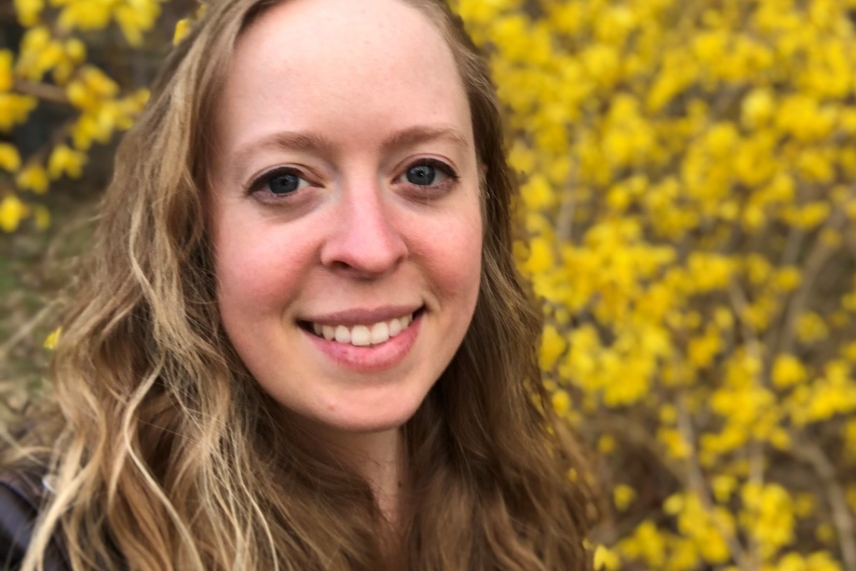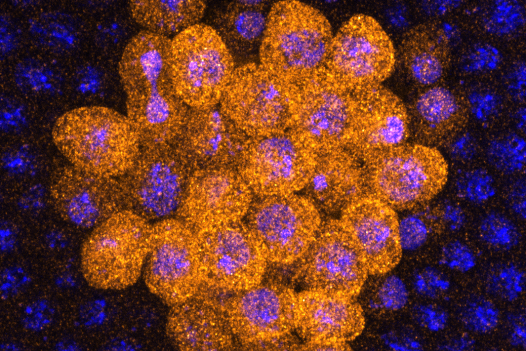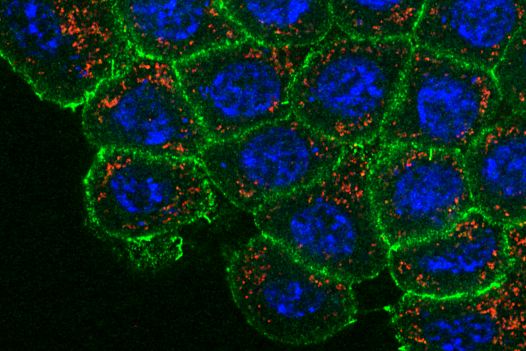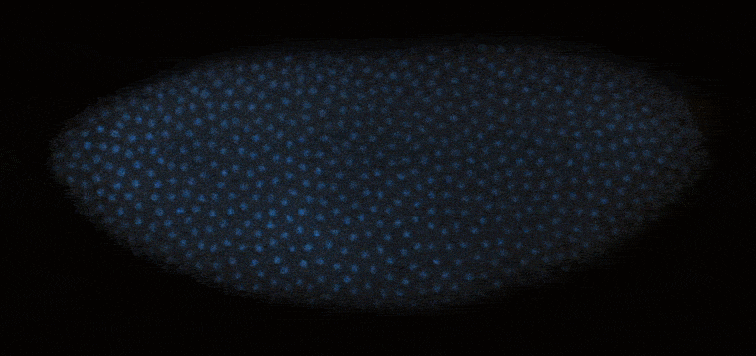
Whitehead Institute postdoc Melissa Pamula
Courtesy of Melissa Pamula
Meet a Whitehead Postdoc: Melissa Pamula
Melissa Pamula is a postdoc in Whitehead Institute Director Ruth Lehmann’s lab studying the cells that make and become eggs and sperm. We sat down with Melissa to learn more about her and her experiences in and out of the lab.
What do you investigate?
Everyone in Ruth's lab studies some aspect of germ cell biology, which is the study of cells that become the sperm and egg in an organism. We use Drosophila melanogaster, a kind of fruit fly, to study how these cells are established and protected throughout the life cycle of the fly. Germ cells are formed about two hours after an egg is fertilized. While this is happening, it is really important that the germ cells inherit all of the genetic material that they will need to eventually make a new organism. Often when you think about genetic material, you think about the nucleus, but it's also critically important for these cells to inherit mitochondria (the cell parts that generate energy), because mitochondria contain their own genomes. I'm investigating how mitochondria make it into germ cells so that they can be passed down to the next generation.
What drew you to Ruth’s lab?
Ruth’s lab has made so many fantastic contributions to the field of germ cell biology that I found really exciting, but there is still a lot to do. I felt that the skills I learned in my PhD would fit nicely into this field and complement those that other lab members already had. When I first visited, it seemed like the lab environment was really rigorous but also generous. By that, I mean it seemed like people were able to explore what they wanted to explore scientifically without a lot of restrictions. I knew that as a postdoc, I wanted to be in a place where I could have a lot of independence. Ruth treats all members of her lab as colleagues and really engages with them at a high intellectual level, and that's the kind of place that I wanted to be.

Close-up of the posterior end of a fruit fly embryo. DNA is shown in blue and germ cells, marked by the protein vasa, are shown in orange.
Melissa Pamula/Whitehead Institute

Close-up of the posterior end of a fruit fly embryo. DNA is shown in blue, the actin cytoskeleton in germ cells is shown in green, and mitochondria are shown in red.
Melissa Pamula/Whitehead Institute
Ruth’s lab is relatively new to Whitehead Institute, having moved from NYU. When did you move to Cambridge?
The lab moved in December, and I was on maternity leave at the time so I moved a little bit later and then came back to work on February 1st. I've been in Massachusetts for a couple months now. When I started my postdoc, I fully expected to be in New York for a long time so when Ruth’s lab moved, I didn't know what to expect out of Boston or Cambridge, but every aspect of it so far has been really great.
What has been your experience of Whitehead Institute so far?
It's been fantastic because it's such a small community, so I felt like I was part of it almost immediately. I remember the first week I was here, Audrey, the person that used to check everyone in, said to me on my third day, “Oh, I know who you are!” Even though that was such a small interaction, it's just nice to see the same faces every day and have that familiarity. Another example is when I needed help doing some qPCR (a type of experiment that measures DNA), Jen and Amanda at the genome core were super friendly and extremely helpful. They met with me right away, got me trained and helped me troubleshoot much quicker than I was expecting. I'm glad I'm here, and I’m looking forward to meeting everyone else once more in-person events start up again.
What are your hobbies outside of work?
I just moved to a house that has a big backyard, so I can actually go outside and do some gardening and enjoy the wildlife. I spent the last seven years in and around New York City where it's pretty hard to have a lot of green space, so I really enjoy getting outside now. I love hiking and foraging for wild edible mushrooms. I think that's a really fun hobby, and if I find something that's edible then we take it home and cook it up.
What is your favorite dish to make with mushrooms?
There is a brilliant orange mushroom called chicken of the woods, and if you prepare it as you would a piece of chicken, it tastes exactly the same. My favorite thing is to bread it, fry it up, and eat it like a chicken sandwich.
What are the steps of preparing a foraged mushroom for a meal?
The first step is to unambiguously identify the mushroom. There are a few that really look like nothing else in the mushroom kingdom so it's absolutely clear what they are. Chicken of the woods is one of what is called the “foolproof four”, because it looks so unlike anything dangerous that if you find it, you can be confident that it is safe to eat. There are a lot of other kinds of wild edible mushrooms that have a risk attached to them because they might look very similar to something that's not edible, and so those are really only for if you're very experienced or very knowledgeable. If you aren't certain of the identity, then you can do what’s called a spore print. You take the cap of the mushroom and you put it on a piece of paper—it's best if you do it where half of the cap is on a black piece of paper and half of it's on a white piece of paper—and then the spores fall off onto that paper, and it leaves an imprint of what the cap looks like underneath. This also shows the color of the spores, so for example you might find a mushroom that visually looks like it could possibly be one of two different species, but the edible one has white spores and the poisonous one has purple spores, and that will be really obvious when you do a spore print. Then you can say, okay, now I know for 100% sure that it is this good variety and not this bad variety—or now I know we shouldn’t eat this. This happened recently where I thought I had some delicious honey mushrooms, but doing a spore print revealed that they were actually poisonous sulphur tufts!

Spore print of sulfur tuft mushroom (Hypholoma fasciculare)
Melissa Pamula/Whitehead Institute
What did you want to be as a kid?
I wanted to be an artist. For most of my youth I was always coloring, drawing pictures, and taking art classes, and it was something that I thought that I would do for my entire life. Then in high school, I started to take science classes, and I realized that when I was trying to capture in my art was the intricacy and complexity of the physical world. It’s easy to appreciate the beauty of autumn, when leaves change from green to red, orange, and yellow, but I remember when I first learned why that happened, from the level of leaf biology, I thought it was even more incredible. I realized that my curiosity about the world can be satisfied by learning about it from a biologist’s perspective, so that's what drew me into science.
Given your artistic background, are you particularly excited by visually stunning things in the lab?
Yes, absolutely. I mean, I have a whole Google account where I just send myself gifs of cool cell biology images and movies that I take in the lab. A lot of my work in the lab is using microscopes to image cells at high magnification. Sometimes I spend too much time there because I'll get excited when I see something cool and lose track of time and I have to remind myself that there are other things I have to do today. I find it very easy to spend time on the microscope for many more hours than I intended to.

What would you tell a student is the most exciting thing about your job?
The best part about this job is that you get to truly learn something new about the world, about biology. For almost every experiment that you do, even if the protocol has been done before, you're applying it to something new that no one else has ever done. That's the whole point! So if you feel excited at the thought of learning something that no one else has ever learned before, then this is the job for you. You'll never get bored.
Where do you see yourself in ten years?
I really want to run my own lab. I'm also falling in love with this area. So my dream would be to get an offer for an academic position here. If not, hopefully somewhere on the East Coast.
Contact
Communications and Public Affairs
Phone: 617-452-4630
Email: newsroom@wi.mit.edu


